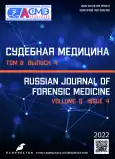Возможности диагностики колото-резаных повреждений у живых лиц с использованием результатов компьютерной томографии
- Авторы: Леонов С.В.1,2, Пинчук П.В.1,3, Шакирьянова Ю.П.1,2, Троян В.Н.4
-
Учреждения:
- Главный государственный центр судебно-медицинских и криминалистических экспертиз
- Московский государственный медико-стоматологический университет имени А.И. Евдокимова
- Российский национальный исследовательский медицинский университет имени Н.И. Пирогова
- Главный военный клинический госпиталь имени Н.Н. Бурденко
- Выпуск: Том 8, № 4 (2022)
- Страницы: 89-96
- Раздел: Экспертная практика
- URL: https://journals.rcsi.science/2411-8729/article/view/122478
- DOI: https://doi.org/10.17816/fm716
- ID: 122478
Цитировать
Полный текст
Аннотация
В настоящее время в лечебно-диагностическую практику крупных больниц внедрены такие современные методы исследования, как компьютерная и магнитно-резонансная томография. Указанные методы исследования применяются практически повсеместно для диагностики различных видов травм, а их результаты вместе с медицинскими документами пострадавших работники правоохранительных органов и судов предоставляют в государственные судебно-медицинские экспертные учреждения для производства судебно-медицинских экспертиз. Исследование результатов компьютерной и магнитно-резонансной томографии позволяет решать экспертные вопросы в случаях экспертиз и исследований живых лиц.
В статье приведён случай из экспертной практики, демонстрирующий возможности установления особенностей морфологии и локализации колото-резаных повреждений, количества травмирующих воздействий и направления раневых каналов с использованием результатов прижизненной компьютерной томографии и трёхмерного моделирования. В описываемом экспертном случае первоначально в представленных медицинских документах имелись противоречивые сведения о количестве, локализации и механизме образования причинённых потерпевшему ран. Для устранения имевшихся противоречий были исследованы рубцы на теле потерпевшего, а также результаты компьютерной томографии, выполненной потерпевшему в медицинском учреждении при поступлении. Для более полной визуализации наружных повреждений из данных компьютерной томографии была воссоздана трёхмерная модель тела потерпевшего. В результате проведённого исследования удалось чётко воссоздать картину имевшихся у пострадавшего повреждений и ответить на вопросы о механизме и условиях их причинения.
Описанный случай демонстрирует возможности экспертных исследований и новые методические подходы к решению судебно-медицинских задач, что в настоящее время достаточно актуально, поскольку в последние годы в судебной медицине активно развивается методика посмертного исследования тела ― виртопсия. Изложенные в статье приёмы исследования вполне могут быть применены в отношении трупа с колото-резанными повреждениями, что, вероятно, позволит более точно визуализировать направление и форму раневого канала.
Ключевые слова
Полный текст
Открыть статью на сайте журналаОб авторах
Сергей Валерьевич Леонов
Главный государственный центр судебно-медицинских и криминалистических экспертиз; Московский государственный медико-стоматологический университет имени А.И. Евдокимова
Автор, ответственный за переписку.
Email: sleonoff@inbox.ru
ORCID iD: 0000-0003-4228-8973
SPIN-код: 2326-2920
д.м.н., профессор
Россия, 105094, Москва, Госпитальная площадь, д. 3; МоскваПавел Васильевич Пинчук
Главный государственный центр судебно-медицинских и криминалистических экспертиз; Российский национальный исследовательский медицинский университет имени Н.И. Пирогова
Email: pinchuk1967@mail.ru
ORCID iD: 0000-0002-0223-2433
SPIN-код: 7357-3038
д.м.н., доцент
Россия, 105094, Москва, Госпитальная площадь, д. 3; МоскваЮлия Павловна Шакирьянова
Главный государственный центр судебно-медицинских и криминалистических экспертиз; Московский государственный медико-стоматологический университет имени А.И. Евдокимова
Email: tristeza_ul@mail.ru
ORCID iD: 0000-0002-1099-5561
SPIN-код: 1429-6230
д.м.н.
Россия, 105094, Москва, Госпитальная площадь, д. 3; МоскваВладимир Николаевич Троян
Главный военный клинический госпиталь имени Н.Н. Бурденко
Email: vtroyan10@yahoo.com
ORCID iD: 0000-0002-8008-9660
SPIN-код: 4937-3162
д.м.н., профессор
Россия, МоскваСписок литературы
- Шакирьянова Ю.П., Леонов С.В., Курбанов С.И. Возможности компьютерной томографии в судебно-медицинских исследованиях // Избранные вопросы судебно-медицинской экспертизы: сборник статей / под ред. А.И. Авдеева, И.В. Власюка, А.В. Нестерова. Хабаровск, 2019. С. 201–205.
- Andenmatten M.A., Thali M.J., Kneubuehl B.P., et al. Gunshot injuries detected by post-mortem multislice computed tomography (MSCT): a feasibility study // Legal Medicine (Tokyo). 2008. Vol. 10, N 6. P. 287–292. doi: 10.1016/j.legalmed.2008.03.005
- Дадабаев В.К., Троян В.Н. Использование спиральной компьютерной томографии в судебной медицине // Медицинская экспертиза и право. 2011. № 2. С. 36–39.
- Дадабаев В.К., Алексеев Р.К., Ромодановский П.О., и др. Роль лучевых методов исследования в диагностике и установления механизма детского травматизма // Тверской медицинский журнал. 2019. № 5. С. 62–71.
- Клевно В.А., Чумакова Ю.В. Виртопсия ― новый метод исследования в отечественной практике судебной медицины // Актуальные вопросы судебной медицины и экспертной практики: тезисы докладов международного конгресса, 17–19 апреля. Москва, 2019. С. 46.
- Thali M.J., Braun M., Buck U., et al Virtopsy--Scientific documentation, reconstruction and animation in forensic: individual and real 3D data based geo-metric approach including optical body/object surface and radiological CT/MRI scanning // J Forensic Sci. 2005. Vol. 50, N 2. Р. 428–442.
Дополнительные файлы










